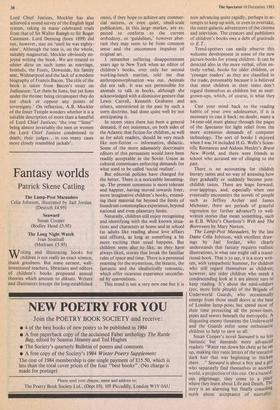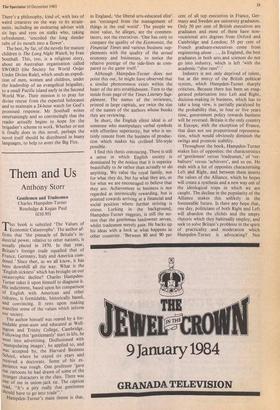Fantasy worlds
Patrick Skene Catling
The Lamp-Post Marauders Celia Johnson, illustrated by Jael Jordan (Deutsch £4.95) Seaward Susan Cooper (Bodley Head £5.95) The Long Night Watch Ivan Southall (Methuen £5.95)
Writing and illustrating books for children is not really an exact science, thank goodness. But some earnest, well- intentioned teachers, librarians and editors of children's books propound annual theories which amount to diktats. Writers and illustrators (except the long-established
ones), if they hope to achieve any commer- cial success, or even quiet, small-scale publication, in this large market, are ex- pected to conform to the current orthodoxy, or 'guidelines,' however aber- rant they may seem to be from common sense and the uncommon impulses of original art.
I remember suffering disappointment years ago in New York when an editor of children's books, over only her second working-lunch martini, told me that ant hropomorphisation was out. Animals did not talk. It was not permissible for animals to talk in books, although she acknowledged with a dismissive gesture that Lewis Carroll, Kenneth Grahame and others, unrestricted in the past by such a stern doctrine, had done quite well by not anticipating it.
In recent years there has been a general demand, if not insistence, on both sides of the Atlantic that fiction for children, as well as for adult readers, should be very much like non-fiction — informative, didactic. Some of the more adamantly doctrinaire editors of' this persuasion would have been readily acceptable in the Soviet Union as cultural commissars enforcing demands for what used to be called 'social realism'.
But editorial policies have changed for the better. There is a noticeable loosening- up. The present consensus is more tolerant and happier, having moved towards freer, more imaginative children's books, extend- ing their material far beyond the limits of humdrum commonplace experience, beyond national and even planetary limits.
Naturally, children still enjoy recognising and identifying with the well known situa- tions and characters at home and at school (as adults like reading about love affairs and offices), as long as something a bit more exciting than usual happens. But children seem also to like, as they have always liked, stories that break the familiar rules of space and time. There is a perennial yearning for the mysterious, the bizarre, the fantastic and the idealistically romantic, which offer vicarious experience unconfin- ed by conventions.
This trend is not a very new one but it is now advancing quite rapidly, perhaps in at- tempts to keep up with, or even to overtake,
the outer-galactic adventurers of the cinema and television. The creators and publishers of children's books owe a debt of gratitude to E.T.
Trend-spotters can easily observe this welcome development in some of the new picture-books for young children. It can be detected also in the more verbal, often en- tirely verbal, books for older children, or 'younger readers' as they are classified in the trade, presumably because it is believed that most children in their teens don't regard themselves as children but as near- grown-ups, which, of course, is what they are.
Cast your mind back to the reading habits of your own adolescence, if it is necessary to cast it back; no doubt, many a
14-year-old must glance through the pages of the Spectator for light relief from the
more strenuous demands of computer technology. The sort of books I enjoyed when I was 14 included H.G. Wells's Scien-
tific Romances and Aldous Huxley's Brave New World, and there were friends at School who accused me of clinging to the past.
There is no accounting for childish literary tastes and no way of assessing how they gradually or suddenly become post- childish tastes. There are leaps forward, over-lappings, and, especially when one
eventually encounters the novels of people such as Jeffrey Archer and James Michener, there are periods of grateful regression (or further advance?) to well- written stories that mean something, such• as E.B. White's Charlotte's Web and The Borrowers by Mary Norton.
The Lamp-Post Marauders, by the late Dame Celia Johnson, with excellent draw-
ings by Jael Jordan, who clearly understands that fantasy requires realistic illustrations, is what one might call a transi- tional book. That is to say, it is a story writ- ten, with sympathetic humour, for children who still regard themselves as children; however, any older children who sneak a condescending look at it are almost sure to keep reading. It's about the mini-soldiers
(yes, more little rieople) of the Brigade of
Underworld Guards, who occasionally emerge from those small doors at the base
of London lamp-posts but spend most of
their time protecting all the power-lines, pipes and sewers beneath the metropolis. A disgusting enemy threatens the Underworld and the Guards enlist some enthusiastic children to help to save us all.
Susan Cooper's novel Seaward is no less fantastic but demands more advanced readers: 'Water ran down his chest as he sat up, making tiny runic letters of the tentative dark hair that was beginning to thicken there... Seaward is about a boy and a girl who separately find themselves in another world, a projection of this one. On a hazard- ous pilgrimage, they come to a place where they learn about Life and Death. The story is an alarming but finally consoling myth about acceptance of mortality.
There's a philosophy, kind of, with lots of weird creatures on the way to its attain- ment, including an endearing adviser with six legs and eyes on stalks who, taking refreshment, 'uncoiled the long slender tube of its mouth into a flower'.
The best, by far, of the novels for mature children is The Long Night Watch, by Ivan Southall. This, too, is a religious story, about an Australian organisation called SWORD (the Society for World Order Under Divine Rule), which sends an expedi- tion of men, women and children, under the leadership of an evangelical brigadier, to a small Pacific island early in the Second World War. Their mission is to pray for divine rescue from the expected holocaust and to maintain a 24-hour watch for God's promised response. Mr Southall writes entertainingly and so convincingly that the reader actually begins to hope for the brigadier's scheme to work. Whether or not it finally does in this novel, perhaps the novel itself should be distributed in finny languages, to help to avert the Big Fire.















































 Previous page
Previous page